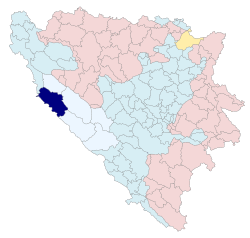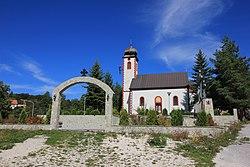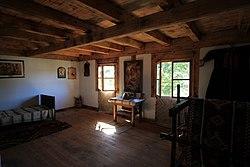Bosansko Grahovo Босанско Грахово | |
|---|---|
Town and municipality | |
 Bosansko Grahovo | |
 Location of Bosansko Grahovo within Bosnia and Herzegovina | |
| Coordinates: 44°10′46″N 16°21′52″E / 44.17944°N 16.36444°E | |
| Country | Bosnia and Herzegovina |
| Federation | Bosnia and Herzegovina |
| Canton | 10 |
| Government | |
| • Municipality president | Uroš Đuran (SNSD) |
| Area | |
| • Total | 780 km2 (300 sq mi) |
| Population (2013 census) | |
| • Total | 2,449 |
| • Density | 3.1/km2 (8.1/sq mi) |
| Time zone | UTC+1 (CET) |
| • Summer (DST) | UTC+2 (CEST) |
| Area code(s) | +387 34 |
| Website | http://www.bosanskograhovo.ba |
Bosansko Grahovo (Serbian Cyrillic: Босанско Грахово) is a town and municipality located in Canton 10 of the Federation of Bosnia and Herzegovina, an entity of Bosnia and Herzegovina. It is situated in western Bosnia and Herzegovina near the border with Croatia.
History
Gavrilo Princip, the main perpetrator of the assassination of Archduke Franz Ferdinand in Sarajevo in 1914, was born in the village of Obljaj located just east of Bosansko Grahovo.
From 1929 to 1941, Bosansko Grahovo was part of the Vrbas Banovina of the Kingdom of Yugoslavia. In the Drvar uprising Grahovo was captured by the Serb rebels commanded by Branko Bogunović.[1] Bogunović joined Yugoslav Army in the Fatherland and in September 1941 he was appointed as commander of the Chetnik Regiment "Gavrilo Princip" from Grahovo.
During the Bosnian War, the city was held by Bosnian Serb forces. The Croatian Army captured the city in July 1995, during Operation Summer '95.[2] The offensive displaced a large number of Serb refugees. After the war, the Serb civilians returned, and today they constitute the majority of population in the municipality.[3] However, nowadays the population is much smaller, having declined from 9,000 to about 2,500.
Settlements
- Bastasi
- Bosansko Grahovo
- Crnac
- Crni Lug
- Donje Peulje
- Donji Kazanci
- Donji Tiškovac
- Duler
- Gornje Peulje
- Gornji Kazanci
- Grkovci
- Isjek
- Jaruga
- Kesići
- Korita
- Luka
- Maleševci
- Malo Tičevo
- Marinkovci
- Mračaj
- Nuglašica
- Obljaj
- Pečenci
- Peći
- Preodac
- Pržine
- Radlovići
- Resanovci
- Stožišta
- Ugarci
- Uništa
- Veliko Tičevo
- Vidovići
- Zaseok
- Zebe
Demographics
Population
| Population of settlements – Bosansko Grahovo municipality | ||||||
|---|---|---|---|---|---|---|
| Settlement | 1961. | 1971. | 1981. | 1991. | 2013. | |
| Total | 10,196 | 10,555 | 9,032 | 8,311 | 3,091 | |
| 1 | Bosansko Grahovo | 696 | 1,229 | 1,602 | 2,096 | 651 |
| 2 | Peći | 256 | 203 | |||
Ethnic composition
| Ethnic composition – Bosansko Grahovo town | |||||||
|---|---|---|---|---|---|---|---|
| 2013 | 1991 | 1981 | 1971 | 1961 | |||
| Total | 651 (100.0%) | 2,096 (100.0%) | 1,602 (100.0%) | 1,229 (100.0%) | 696 (100.0%) | ||
| Serbs | 600 (92.17%) | 1,999 (95.37%) | 1,358 (84.77%) | 1,167 (94.96%) | 670 (96.26%) | ||
| Croats | 45 (6.912%) | 14 (0.668%) | 26 (1.623%) | 25 (2.034%) | 14 (2.011%) | ||
| Others | 6 (0.922%) | 16 (0.763%) | 3 (0.187%) | 8 (0.651%) | 3 (0.431%) | ||
| Yugoslavs | 61 (2.910%) | 193 (12.050%) | 18 (1.465%) | 4 (0.575%) | |||
| Bosniaks | 6 (0.286%) | 4 (0.250%) | 11 (0.895%) | ||||
| Montenegrins | 12 (0.749%) | 5 (0.718%) | |||||
| Albanians | 6 (0.375%) | ||||||
| Ethnic composition – Bosansko Grahovo municipality | |||||||
|---|---|---|---|---|---|---|---|
| 2013 | 1991 | 1981 | 1971 | 1961 | |||
| Total | 3,091 (100.0%) | 8,311 (1000%) | 9,032 (100.0%) | 10,555 (100.0%) | 10,196 (100.0%) | ||
| Serbs | 2,028 (82.81%) | 7,888 (94.91%) | 7,739 (85.68%) | 10,100 (95.69%) | 9,787 (95.99%) | ||
| Croats | 393 (16.050%) | 226 (2.719%) | 264 (2.923%) | 364 (3.449%) | 368 (3.609%) | ||
| Others | 22 (0.898%) | 50 (0.602%) | 25 (0.277%) | 40 (0.379%) | 6 (0.059%) | ||
| Bosniaks | 6 (0.245%) | 12 (0.144%) | 5 (0.055%) | 14 (0.133%) | 2 (0.020%) | ||
| Yugoslavs | 135 (1.624%) | 978 (10.830%) | 37 (0.351%) | 22 (0.216%) | |||
| Montenegrins | 15 (0.166%) | 11 (0.108%) | |||||
| Albanians | 6 (0.066%) | ||||||
Notable people
- Dragan Raca, basketball coach
- Đuro Pucar, politician
- Gavrilo Princip, assassin of Archduke Franz Ferdinand of Austria-Hungary
- Ksenija Pajčin, singer
- Milan Galić, footballer
See also
References
- ^ (Plećaš & Dimitrijević 2004, p. 267):"Устаници у западној Босни, под вођством Мане Роквића, заузели су Дрвар, а Брана Богуновић је са својима заузео Босанско Грахово"
- ^ Central Intelligence Agency, Office of Russian and European Analysis (2002). Balkan Battlegrounds: A Military History of the Yugoslav Conflict, 1990–1995. Washington, D.C.: Central Intelligence Agency. p. 366. OCLC 50396958.
- ^ http://www.novosti.rs/vesti/planeta.70.html:333051-Srbi-u-Grahovu-ni-pisma-ne-nose
Sources
- Plećaš, Neđeljko; Dimitrijević, Bojan (2004). Ratne godine. Institut za savremenu istoriju.

